The Saints began the post-Drew Brees era in 2021, a season which included mixed results. New Orleans’ defense stood out as one of the best units in the NFL, but its offense struggled down the stretch in particular, leaving the team outside of the playoff picture. The absence of wideout Michael Thomas was exacerbated by the midseason loss of Brees’ successor, Jameis Winston (leading to a league-worst passing attack), and the questions surrounding their respective futures clouded the onset of the offseason.
More headlines were made when Sean Payton, the only coach to lead the franchise to a Super Bowl, stepped away from the team. A number of changes among the coaching staff were therefore necessary; likewise, another offseason of the salary cap gymnastics general manager Mickey Loomis has become known for were required to manufacture roster flexibility. Given the moves made in that regard, some notable names have arrived, leading to renewed optimism for a postseason run. Will the franchise’s handling of new and old obstacles return them to contender status?
Free agent additions:
- Tyrann Mathieu, S. Three years, $27MM. $18MM guaranteed.
- Marcus Maye, S. Three years, $22.5MM. $14.5MM guaranteed.
- Jarvis Landry, WR. One year, $3MM. $3MM guaranteed.
- Andy Dalton, QB. One year, $3MM. $3MM guaranteed.
- Daniel Sorensen, S. One year, $1.27MM. $500K guaranteed.
- Kentavius Street, DE. One year, $1.27MM. $300K guaranteed.
- Nick Martin, C. One year, $1.19MM. $153K guaranteed. (Signed to practice squad 8/31).
- Eric Wilson, LB. One year, $1.04MM. (Signed to practice squad 8/31).
- Josh Andrews, OL. One year, $1.04MM. (Signed to practice squad 8/31).
- Taco Charlton, DE. One year, $1.04MM. (Signed to practice squad 8/31).
- J.P. Holtz, TE. One year, $965K. (Signed to practice squad 8/31).
With limited finances to work with, it is unsurprising that only two multiyear deals were handed out. Likewise, the  fact that they each went to safeties comes as little shock, with both starting spots needing to be filled. Mathieu spent much more time on the free agent market than his pedigree would have suggested, but he will still manage to reach the eight-figure-per-year mark with his hometown team should he maximize the pact’s incentives. The LSU alum and New Orleans native drew interest from teams like the Rams, Steelers and Eagles, but the Saints had long been considered his eventual landing spot in the buildup to his signing.
fact that they each went to safeties comes as little shock, with both starting spots needing to be filled. Mathieu spent much more time on the free agent market than his pedigree would have suggested, but he will still manage to reach the eight-figure-per-year mark with his hometown team should he maximize the pact’s incentives. The LSU alum and New Orleans native drew interest from teams like the Rams, Steelers and Eagles, but the Saints had long been considered his eventual landing spot in the buildup to his signing.
During a highly productive three-year stint in Kansas City, Mathieu increased his Pro Bowl and All-Pro appearance totals twice each, and was a key member (both in terms of on-the-field effectiveness as well as leadership and communication) of their Super Bowl LIV-winning team. The Chiefs declined to offer the 30-year-old a new deal, however, turning to the younger Justin Reid in free agency. The Honey Badger’s consistent ball production and PFF grades during recent years point to a fall-off being unlikely during at least the early part of the contract, meaning that the backend of the Saints’ defense could be in line for more of what Kansas City’s has enjoyed during its run of AFC dominance.
Maye comes with more concerns from an availability standpoint but should give New Orleans a great deal of versatility and playmaking in the secondary. Ending his Jets tenure on the franchise tag, the 29-year-old was limited to just six games last season due to a torn Achilles. It was widely assumed that the injury – along with legal troubles, which may already be an issue in New Orleans – would mark the end of his time in New York, but a new contract was deemed a possibility at the onset of free agency. Ultimately, though, the Jets pivoted to Jordan Whitehead, leaving the Saints with a new tandem at safety which has the potential to prove the team’s investment in them worthwhile.
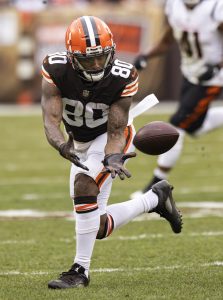 Just as was the case with Mathieu, the Landry signing represented a homecoming. The LSU product’s deal also features incentives which can double its value; even in that event, the contract would fall well short of the $20MM per year he was once reported to be seeking. Still, the one-year pact gives Landry a chance to move forward from an injury-riddled final year with the Browns, re-establishing his worth as a dependable slot receiver. He will face notable competition for targets, but the former Pro Bowler (if healthy) could be in line for a productive season, and a resultant financial windfall.
Just as was the case with Mathieu, the Landry signing represented a homecoming. The LSU product’s deal also features incentives which can double its value; even in that event, the contract would fall well short of the $20MM per year he was once reported to be seeking. Still, the one-year pact gives Landry a chance to move forward from an injury-riddled final year with the Browns, re-establishing his worth as a dependable slot receiver. He will face notable competition for targets, but the former Pro Bowler (if healthy) could be in line for a productive season, and a resultant financial windfall.
Given their lack of established pass catchers aside from Amari Cooper, a reunion with the Browns was considered a possibility for Landry, even after they released him. Only in the days before the 29-year-old signed with the Saints did it become clear that Cleveland was fully committed to other options. Landry brings significant pedigree and a veteran presence to what was one of the league’s worst position groups last season, and could be a central figure in its 2022 ascension.
If things go according to plan, Dalton will not play nearly as large of a role as Landry despite the similarities in their contracts. Should Winston suffer a setback in his recovery, or find himself sidelined again, the 34-year-old would give the Saints a more capable insurance option than most. Bouncing around to three teams in as many seasons, the longtime Bengals starter has seen significant playing time since becoming a backup. His performances and win-loss record over that span suggests the team would be far better equipped to handle a repeat of last season’s injury troubles than the 2021 version.
Re-signings:
- Jameis Winston, QB. Two years, $28MM. $15.2MM guaranteed.
- P.J. Williams, S. One year, $2.54MM. $2.54MM guaranteed.
- Tre’Quan Smith, WR. Two years, $6MM. $2MM guaranteed.
- Carl Granderson, DE. Two years, $5.27MM. $240K guaranteed.
- Dwayne Washington, RB. One year, $1.19MM. $53K guaranteed.
- Ethan Greenidge, T. One year, $1MM. $100K guaranteed.
- Albert Huggins, DT. One year, $895K.
- Juwan Johnson, TE. One year, $895K.
- Christian Ringo, DL (signed to practice squad 9/1)
Winston’s injury and free agent status left the Saints with a complicated situation at the quarterback position. The fact that Taysom Hill permanently transitioned to tight end, and the team’s cap challenges seemingly left them without many options. One of those, of course, was simply a reunion with Winston. The team’s 5-2 record with him as the starter prior to his ACL tear was due, in part, to his impressive 14:3 touchdown-to-interception ratio. To little surprise, then, Loomis confirmed in before the onset of free agency that a third contract with the former No. 1 pick was a distinct possibility. 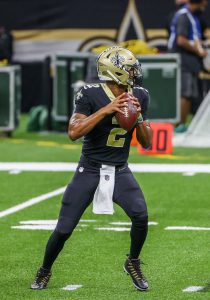
However, the Saints carved out enough cap space to enter the QB market which dominated the NFL landscape this spring. That made them a player for Deshaun Watson. Barely one week after the news of a Winston reunion still being on the table, New Orleans made Houston an offer to acquire the embattled signal-caller. The Saints were joined in pursuing Watson by the Panthers and Falcons, and it seemed all but assured at one point that he was headed somewhere in the NFC South. The Browns emerged as the team willing to make the biggest contract offer – a five-year, $230MM fully guaranteed contract – to move the Saints from a reported Watson finalist to a team needing to pivot back to Winston.
The 28-year-old has made steady progress rehabbing his knee throughout the offseason. Winston’s appearance in the team’s preseason finale was another encouraging sign that he will be fully recovered in time for the 2022 campaign. Smith will also return as a familiar face in the passing game, though the former third-round pick’s underwhelming performance with an increased role last season led, no doubt, to his modest deal and the team’s emphasis on upgrading the WR corps.
On defense, Williams and Granderson are each in line to continue playing important rotational roles. The former has proven himself to be a versatile member of the secondary by filling a number of positions, while the latter earned a significantly more lucrative deal than his ERFA status required. Once again facing a limited budget for re-signings, the Saints keeping both in the fold at their respective rates could prove fruitful if they are forced into starting roles.
Notable losses:
- Kwon Alexander, LB
- Kiko Alonso, LB (retired)
- Terron Armstead, T
- Caleb Benenoch, OL
- Blake Bortles, QB (released)
- James Carpenter, OL
- Ken Crawley, CB
- Jalen Dalton, DL
- Garrett Griffin, TE
- Jeff Heath, S
- Jalyn Holmes, DL
- Lil’Jordan Humphrey, WR
- Malcolm Jenkins, S (retired)
- Brett Maher, K
- Jordan Miller, CB
- Jordan Mills, T
- Ty Montgomery, RB
- Craig Robertson, LB (retired)
- Trevor Siemian, QB
- Kenny Stills, WR
- Marcus Williams, S
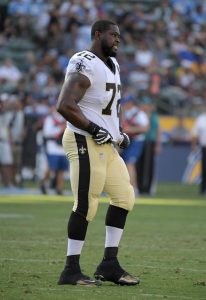 Armstead was rightfully ranked as one of, if not the top free agents in this year’s class; left tackles of his caliber rarely hit the open market. Given the Saints’ financial situation, though, it was inevitable that a new deal would not be viable for the three-time Pro Bowler. His age (31) and injury history (including nine missed games in 2021), on the other hand, left New Orleans in need of a replacement at some point in the short- to intermediate-term future anyway.
Armstead was rightfully ranked as one of, if not the top free agents in this year’s class; left tackles of his caliber rarely hit the open market. Given the Saints’ financial situation, though, it was inevitable that a new deal would not be viable for the three-time Pro Bowler. His age (31) and injury history (including nine missed games in 2021), on the other hand, left New Orleans in need of a replacement at some point in the short- to intermediate-term future anyway.
Miami quickly emerged as a team actively pursuing Armstead and represented a logical destination when he ultimately signed there. The $75MM commitment made by the Dolphins – including substantial guarantees – demonstrated not only their edge over almost every other team in terms of spending power, but their desperate need to upgrade up front. Armstead will give the Dolphins a true Laremy Tunsil successor and help solidify what was arguably the league’s worst offensive line in 2021.
Williams’ departure was likewise a significant loss on defense, but one which was unsurprising. The 26-year-old played on the franchise tag last season, adding another pair of interceptions to his overall tally of 15, and setting new career-highs in terms of coverage statistics. That made him one of several benefactors of the upward safety market from this offseason, landing a $14MM-per-year contract in Baltimore. Given the Saints’ cap complications, a deal of similar value keeping him in New Orleans was simply unfeasible.
Williams’ emerging presence as one of the league’s top ball hawks will be difficult to replace, in spite of the new 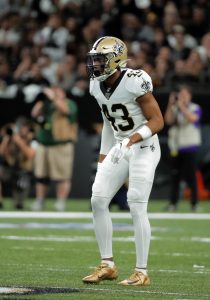 investments made at the position in free agency. Nonetheless, the shorter-term deals given to Mathieu and Maye could see the team use more differentiated looks in the secondary. The fact that their new additions carry only a slightly higher financial burden than Williams alone should also provide a cost-effective tandem on the backend, albeit one once again lacking one of the team’s most accomplished veterans.
investments made at the position in free agency. Nonetheless, the shorter-term deals given to Mathieu and Maye could see the team use more differentiated looks in the secondary. The fact that their new additions carry only a slightly higher financial burden than Williams alone should also provide a cost-effective tandem on the backend, albeit one once again lacking one of the team’s most accomplished veterans.
Jenkins’ retirement marked the second time he left the Saints without his consistent playmaking. Upon his announcement, new head coach Dennis Allen echoed the sentiments expressed by his predecessor, Sean Payton, with respect to Jenkins’ contributions to the franchise. The three-time Pro Bowler remained an every-down starter in his second stint in New Orleans, providing similar production to his five years spent with the team to begin his career and the six spent with the Eagles. Mathieu represents one of the few replacement options capable of filling the 34-year-old’s leadership void.
Alexander proved to be an effective trade acquisition midway through the 2020 campaign. A starter for 15 of the 19 games he appeared in with the Saints, his deal with the Jets proves the degree to which his sizable 49ers contract was a mistake. It also leaves New Orleans with a hole in its linebacking corps with respect to Demario Davis compliments, however, especially given their short-lived reunion with Alonso.
Draft picks:
- 1-11: Chris Olave, WR (Ohio State)
- 1-19: Trevor Penning, T (Northern Iowa)
- 2-49: Alontae Taylor, CB: (Tennessee)
- 5-161: D’Marco Jackson, LB (Appalachian State)
- 6-194: Jordan Jackson, DT (Air Force)
- 6 – Forfeited due to COVID-19 protocol violation
 Their aggressiveness in the buildup to Olave’s and Penning’s selections speak to how the Saints held the pair in high regard. In the former’s case, a trade up of five spots made him the third wideout off the board. Olave never put up the kind of numbers one might expect given that draft slot, though his final season with the Buckeyes was his most productive. Olave also led the team in receiving during the two years prior and was a consistent contributor in an offense featuring significant competition for targets.
Their aggressiveness in the buildup to Olave’s and Penning’s selections speak to how the Saints held the pair in high regard. In the former’s case, a trade up of five spots made him the third wideout off the board. Olave never put up the kind of numbers one might expect given that draft slot, though his final season with the Buckeyes was his most productive. Olave also led the team in receiving during the two years prior and was a consistent contributor in an offense featuring significant competition for targets.
At 6-foot-1, 190 pounds, Olave can operate both outside and in the slot, something which should increase his effectiveness particularly early on in his career. Slated to serve as a starter alongside Thomas and Landry, Olave could soon emerge as a trusted target given the long-term uncertainty surrounding the accomplished veterans. Expectations will be high considering the team’s investment in him (as opposed to a number other similarly rated pass catchers who were available), but he should be a significant contributor to the team’s passing attack for years to come.
Penning’s career path was far different than Olave’s in college. Early on, at least, the same will likely be true in the NFL. The FCS product earned an invite to the Senior Bowl with his dominant play against lower-level competition. Penning’s performance during the all-star week confirmed his status as a first-round prospect, landing him within the Saints’ range after their sizable trade with the Eagles which was finalized three weeks before the draft. 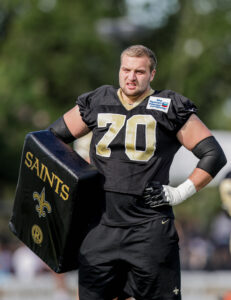
That swap gave New Orleans the extra first-rounder necessary to land Penning (albeit at the expense of its top choice next year and a second-rounder in 2024). The 6-7, 320-pounder established a reputation for himself in the buildup to the draft for his mean streak and physicality. Those qualities give him upside in the run game in particular, but his need for technical refinement left veteran James Hurst as the expected starter to begin Penning’s career. That will be the case out of necessity now, after the latter suffered a foot injury which will keep him sidelined indefinitely to start the campaign. Still, Penning has the upside to replace Armstead as a franchise-caliber blindside blocker should he reach his potential.
Taylor adds another layer of versatility to the Saints’ secondary. After racking up a career-best 60 tackles in his final college season, he showed an ability to play in the slot during training camp. At 6-foot, 193 pounds, the former Volunteer could also line up on the perimeter, giving New Orleans plenty of options in that regard to pair with Marshon Lattimore. Taylor can provide the team with years of cost-controlled play on the backend – along with 2021 third-rounder Paulson Adebo – something which will help counterbalance their financial commitments to a number of veterans.
Extensions and restructures:
- Extended CB Bradley Roby with three year, $10.5MM contract
- Reworked LB Demario Davis’ deal, including one-year extension
- Restructured WR Michael Thomas’ and RT Ryan Ramczyk’s deals, creating $26.22MM in cap space
- Restructured LG Andrus Peat’s pact, converting $8MM into signing bonus and creating $6MM in cap space
- Restructured DEs Cam Jordan’s and Tanoh Kpassagnon’s contracts, creating $12.25MM in cap space
- Restructured RB Alvin Kamara’s contract, converting $10.47MM into signing bonus and creating $8.37MM in cap space
- Restructured CB Marshon Lattimore’s deal, converting $23MM into signing bonus and creating $18.45MM in cap space
- Restructured DE Marcus Davenport’s contract, converting $8.5MM into signing bonus and creating $6.8MM in cap space
- Restructured LT James Hurst and DT David Onyemata’s pacts, creating $7.02MM in cap room
- Restructured TE Taysom Hill’s, LB Demario Davis’ and S Malcolm Jenkins’ deals, creating $17.2MM in cap space
Entering the offseason roughly $75MM in the red for the second straight year, it was obvious that a slew of moves such as these would be necessary. March was dominated by the Saints’ efforts to shed 2022 cap charges, with nine of the team’s top 10 figures being affected. The goal of not only cap compliance, but also the flexibility to make a few noteworthy additions was met, though there will of course be consequences down the road.
The fact that nearly every player listed also went through this process in 2021 leaves the Saints with a number of sideways cap charges beginning in 2023. Thomas represents one such example; he will account for more than $28.2MM on New Orleans’ books next year as things stand. That would fall within the range of market value at his position, given the explosion in receiver salaries this year, should he return to his elite form this season. Signs are pointing toward that being the case, which would alleviate concerns about his long-term future from both a performance and financial perspective.
Trades:
- Sent DB C.J. Gardner-Johnson and 2025 seventh-round pick to Eagles for 2023 fifth-rounder and 2024 sixth
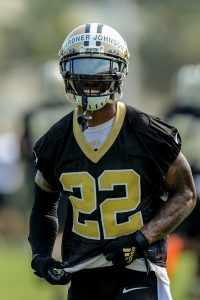 Gardner-Johnson quickly established himself as an invaluable member of the Saints’ defense. The 2019 fourth-rounder was a full-time starter for the past two seasons, proving an effective and productive slot corner. His 112 tackles, four interceptions and 20 pass deflections over that span speak to his abilities both in the run and pass game, though his NFL tenure has of course also included confrontations with teammates and opponents alike. Finances, though, are at the heart of his change of scenery.
Gardner-Johnson quickly established himself as an invaluable member of the Saints’ defense. The 2019 fourth-rounder was a full-time starter for the past two seasons, proving an effective and productive slot corner. His 112 tackles, four interceptions and 20 pass deflections over that span speak to his abilities both in the run and pass game, though his NFL tenure has of course also included confrontations with teammates and opponents alike. Finances, though, are at the heart of his change of scenery.
The Florida alum skipped voluntary workouts in the spring and joined a number of extension-eligible players by staging hold-ins during training camp. The parties remained far apart in contract talks, leading to the team’s decision to move on via trade rather than seeing the 24-year-old depart in free agency next March.
New Orleans will have a number of replacement options given its stable of hybrid defenders, though the move represents a notable loss for the unit. Gardner-Johnson, meanwhile, will reportedly switch to safety in Philadelphia, something which could boost his market value while filling a void in the Eagles’ secondary.
Other:
- Promoted DC Dennis Allen to HC, replacing Sean Payton
- Promoted DBs coach Kris Richard, DL coach Ryan Nielsen to co-DC post
- Retained OC Pete Carmichael, assigning him play-calling duties
- Hired Doug Marrone as OL coach
- RB Alvin Kamara facing potential six-game suspension
- Signed 17 UDFAs
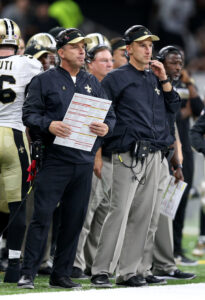 A Saints Watson acquisition likely would have been the only story which could outrank that of Payton’s departure in terms of significance. The 58-year-old was instrumental in the franchise’s Super Bowl title and teamed with Brees to lead the team to 13 consecutive seasons (discounting the 2012 campaign, when he was suspended) with a top-10 total offense. The Saints’ performance in that department slipped over the past two years, but the new Fox broadcaster will be sorely missed as one of the league’s top offensive minds.
A Saints Watson acquisition likely would have been the only story which could outrank that of Payton’s departure in terms of significance. The 58-year-old was instrumental in the franchise’s Super Bowl title and teamed with Brees to lead the team to 13 consecutive seasons (discounting the 2012 campaign, when he was suspended) with a top-10 total offense. The Saints’ performance in that department slipped over the past two years, but the new Fox broadcaster will be sorely missed as one of the league’s top offensive minds.
Payton currently sits in a tie for 21st on the all-time HC wins list and could resume has ascent starting in 2023. He has made clear his desire to coach again and would no doubt have a number of suitors upon his return. Among the teams most frequently connected to him are the Cowboys and Dolphins; a deal sending him to the latter was rumored to be in place as a result of the tampering scandal for which Miami has since been severely disciplined. In any event, Payton’s name will be central to next year’s coaching cycle.
Allen, 49, will be a notably different coach leading the staff, though his extensive history with the franchise should ensure a greater deal of stability than most coaching changes. The team’s defensive coordinator since 2015, Allen was quickly named as the favorite to succeed Payton. The appointment will mark his first HC gig since a Raiders tenure which lasted less than three seasons and resulted in an 8-28 record. Far more will be expected this time around, and his continued work with the defense should give the unit an opportunity to remain in the top five in scoring for a fourth consecutive season.
 Internal promotions will keep the defensive staff intact with Richard and Nielson. The former, like Allen, has DC experience (with the Seahawks). Richard was a candidate to head elsewhere under the same title during the coaching cycle. Nielsen is receiving a new, significant role for the second consecutive year; he was named assistant head coach in 2021. That title has now been given to special teams coordinator Darren Rizzi, further illustrating the by-committee approach the Saints are employing to replace Payton.
Internal promotions will keep the defensive staff intact with Richard and Nielson. The former, like Allen, has DC experience (with the Seahawks). Richard was a candidate to head elsewhere under the same title during the coaching cycle. Nielsen is receiving a new, significant role for the second consecutive year; he was named assistant head coach in 2021. That title has now been given to special teams coordinator Darren Rizzi, further illustrating the by-committee approach the Saints are employing to replace Payton.
Carmichael’s expected role changed in a matter of days given the return of Marrone to the staff. The NFL’s longest-tenured offensive coordinator, Carmichael was thought to be moving to a different position – even reportedly requesting to do so – on the team’s staff while the coach he succeeded as OC in 2009 was brought back into the NFL. Instead, the 50-year-old will guide the offense on gamedays, something he has yet to do on a full-time basis. Marrone’s past with the Saints, along with his HC stints in Buffalo and Jacksonville, will give the unit another experienced voice as the team enters its first campaign without at least one of Payton or Brees since 2005.
A violent altercation in Las Vegas during Pro Bowl weekend led to Kamara facing battery-related charges, leaving him at risk of suspension. Delays in the court proceedings regarding his case have opened the door to the five-time Pro Bowler being eligible to at least start the campaign without issue; the same may remain true until 2023. In spite of the team’s upgraded pass-catching corps, Kamara still projects as the focal point of the offense, so any absence would be a significant blow to their playoff chances.
Top 10 cap charges for 2022:
- Michael Thomas, WR: $13.05MM
- Cam Jordan, DE: $12.43MM
- Marshon Lattimore, CB: $9MM
- Ryan Ramczyk, T: $8.48MM
- Andrus Peat, G: $7.67MM
- David Onyemata, DT: $6.75MM
- Alvin Kamara, RB: $6.13MM
- Demario Davis, LB: $5.9MM
- Wil Lutz, K: $5.57MM
- Taysom Hill, TE: $5.13MM
In spite of the numerous challenges faced at the start of the offseason, along with more than $33MM in dead money, the Saints are now mid-pack in terms of 2022 cap space. Things are set to be much different next year, however, as the team is a projected league-worst $58MM over the cap. Every name among their top 10 2022 cap charges is under contract for the 2023 campaign, but restructures have led to major spikes in their respective financial burdens on future rosters. Loomis will need to be creative once again next spring to keep the team competitive.
Life without Payton will require adjustments, just as the 2021 season did in Brees’ absence. Familiar faces on the sidelines should nevertheless help a veteran-laden team incorporate the new pieces to the puzzle which give this roster significant upside, particularly in the passing game on both sides of the ball. In an NFC which – with a few exceptions – is lacking in heavyweights, the Saints can reasonably be expected to compete for a playoff spot. If the offense takes the step forward it is capable of doing on paper, a postseason run should not be out of the question.
Amazing that the NFL is going to let Kamara play after smashing in someone’s face – on camera.
Dude had it coming tho
As long as you don’t kneel during the anthem, the NFL really doesn’t care. The way they settled the Watson situation so that he’ll very conveniently return just in time to play the Texans in Houston, is a great look into their mindset on these things.
If you’re ok with taking a slap on the wrist, pretty much anything goes as long as it’s not bad enough to actually put you in prison. It’s not amazing/ surprising anymore.
Solid 7 win team.
The Saints made a few good moves to compensate for these losses in signing Landry and Mathieu, in particular. Trevor Penning, while likely not on Armstead’s level in terms of potential, looks like a great pick to take over snaps-wise in the long term. We’ll see where he ends up. However, Armstead’s loss was probably the biggest for New Orleans and is very likely understated in terms of impact. Winston taking over as a full time starter after missing a season to injury makes that left tackle spot all the more important, both due to the novelty of his definitively leading the team and due to his specific playstyle.
Pete Carmichael staying in New Orleans is a huge plus for them. Is he going to give the same results as Sean Payton? No, likely not, but it’s one fewer transition for a team that’s now led by a defensive coach. In a situation like that, having an offensive coordinator who has had a lot of experience-in that system and with that team, no less-is the best option for stability.
While the Landry signing was a good move, I’m still unsure of the WR corps’ ability. This next statement is my opinion, but I just don’t think that Chris Olave will ever be a number one receiver, mostly due to his size. He and Landry both are by far best inside. I realize that Landry was signed after it became clear that the WR corps was lacking, but the Saints really could use another outside receiver to help give opportunities to Landry and/or Olave. I think I would have to wait and see renewed commitment from Thomas to put any stock in him at all. We haven’t seen him be elite with a QB post-Brees, though I think we all know that he likely has the ability. I just don’t know if he’s as committed as he was before. It’s hard to reliably expect him to be a top five receiver at this moment without seeing that.
Dennis Allen really gives me no confidence as a coach, but there’s no denying that defensive talent. The Saints have a great edge attack right now, and their linebackers look the part. They have good players with Mathieu’s addition at safety. However, the loss of GardnerJohnson and Williams will be tests for the new additions. Marcus Maye looked like a great signing, but his assault arrest hangs an enormous cloud over his availability. It’s strange, because he showed no signs of any sort of temperament problems before, but that’s an immensely serious charge. Allen has always liked his safeties, so it won’t be surprising to see the Saints sign yet another. He seems to prefer ranging centerfielders to box players, which is likely enabled by the strong line backing corps, and those types of safeties are harder to find. The corner spot could use some shoring up too, to take pressure off the safeties on the back end in coverage. We may see more safety-heavy nickels if Maye is available, but right now it looks like New Orleans could pick up another corner instead. Anthony Harris would be an interesting name to watch.
I think the defense will be the focal point of the team, but New Orleans’ electing consistency in the coaching ranks should help ease the transition of the team. They’ll likely have drop off, as Allen is certainly not the coach that Payton was, and the uncertainty over Kamara and a couple of roster losses will likely affect their on field product. The rest of their division being worse, however, might even that out. I’d expect them to be mostly good, and Dalton’s signing gives them a huge boost should Winston be hurt or ineffective.